Continuous Cursive Letter Continuous Cursive Letter Paragraph
Did you know there is a specific order to teach cursive letters to promote cursive writing legibility and carryover of cursive handwriting? In this post, you'll learn about cursive writing order to teach letters of the alphabet, including the Handwriting Without Tears letter order for teaching cursive. The order that kids should learn the cursive alphabet, including print letter patterns that are directly transferable to cursive alphabet letters.
order to teach cursive letters
Learning to write the alphabet in cursive, writing one's name in cursive, and writing words in cursive is something that many kids want to do around the second grade.
It's around second grade, or 7-8 years of age that fine motor skills develop in such a way that pencil control and graded precision are developed to enable greater in-hand manipulation, and movement through the range of mobility in the thumb and intrinsic muscles within the hand. This enables pencil movements to become more mobile and fluid, which are pre-requisites for cursive writing skills.
Prior to this skill achievement, handwriting is taught based on pencil strokes, including uppercase letters before lowercase letters because of the developmental aspect of learning letter formations.
Cursive seems like a "grown up" style of communication that kids see adults or older students using and they try to make swoopy writing on their own. Some children can be very motivated to learn to write the alphabet in cursive and use it in their written work.
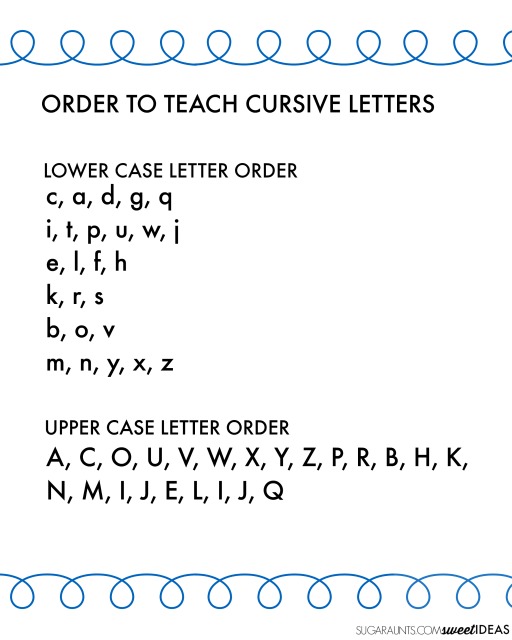
However, one tip for teaching children to write in cursive is to go through the letters in an order that makes sense according to the pencil movements needed to create the letters.
Writing cursive letters in a group of similar pencil strokes is helpful for carryover of pencil control practice and letter formation. Here is more information on teaching groups of similar cursive letters together in a chunk, or cursive letter families.
Once kids have a start on cursive letter formation, they can practice in creative ways like on the window.
Other children who may not be exposed to cursive written work might have their first exposure to cursive in the classroom. Still other students might be in a public or private classroom where cursive handwriting has been dropped from the curriculum. These kids may need extra practice at home or might need to learn cursive handwriting from the very beginning.
But where to start when teaching kids (or adults!) the cursive writing alphabet and how to form words in cursive? Read on for tips and strategies to get started on learning cursive letters.
Cursive Writing Alphabet and Letter Order
We've touched on cursive handwriting in previous posts, include a small piece about starting to teach cursive letters. This strategy will outline the alphabet and the letter order to make learning cursive more easy, based on learning letters in a developmental and progressive order.
RELATED READ: Practice letters in a Cursive Writing Journal.
There are print letter patterns that are directly transferable to cursive letters.
These are cursive letters that are formed similarly to their printed letter counterparts. The muscle movements of the hands that are used to form some printed letters are directly related to the same letters. For this reason, it's a good idea to start with these letters when learning the cursive writing alphabet.
The printed letter patterns that make up some letters will transfer directly to cursive, and when formed with a few subskills, cursive letter formation will easily follow (in most cases):
- Left-to-right strokes
- Good starting points
- Direction of movement
- Consistent stopping points
- Control of downstrokes
- Smooth rhythm
Given the subskills noted above, cursive letter formation will lend to more legible letter formation. Often times, learning correct letter formation and motor practice will help with legibility and ease of cursive writing into a viable form of written communication.
When teaching the cursive alphabet, where to begin?
These letters have print patterns that are directly transferable to their cursive letters:
The following letters transfer directly to their cursive letter forms: c, a, d, g, o, q, i, t, u, j, e, l, f, h, p, n, and m.
Knowing that there are letters that use similar motor plans as a starting point, it is recommended to follow an order when teaching lowercase cursive letters:
- c, a, d, g, q
- i, t, p, u, w, j
e, l, f, h - k, r, s
- b, o, v
- m, n, y, x, z
Upper case cursive letters should be presented in a specific order as well:
A, C, O, U, V, W, X, Y, Z, P, R, B, H, K, N, M, I, J, E, L, I, J, Q
This letter order uses a combination of research-based strategies and focuses on movement based patterns as well as common letter formations, i.e. the way the letters connect to form words.
This upper case cursive letter order (or cursive capital letters) order teaches upper case letters that are similar to lower case letters first. Always teach lower case cursive letters before upper case letters.
Print out the Free printable version for the classroom or home.
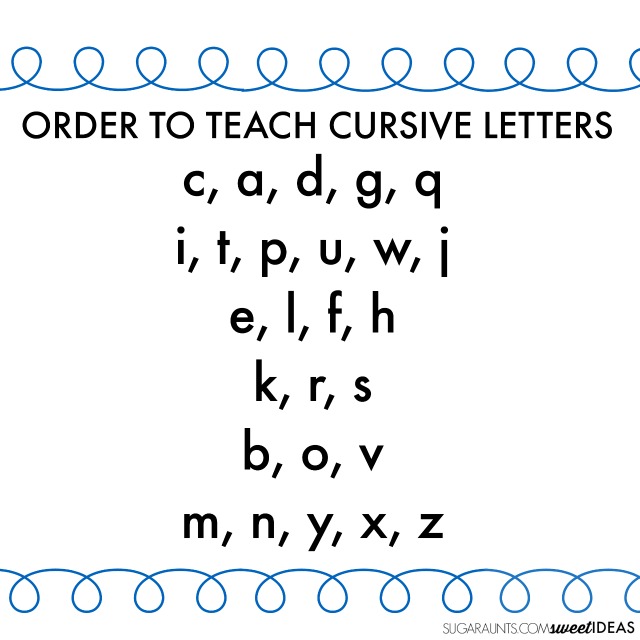
Affiliate links are included below.
WOrk on Cursive Letter Order with these Ideas:
Here, you'll find More creative ways to work on learning cursive writing:
- Fizzy Dough Pre-Cursive lines
- How to teach cursive writing with sensory textures
- Creative Cursive Handwriting Journal
- Napkin Letter Formation Art
- Positioning When Writing in Cursive
- Cursive Writing Lesson Plan
Cursive Writing Order
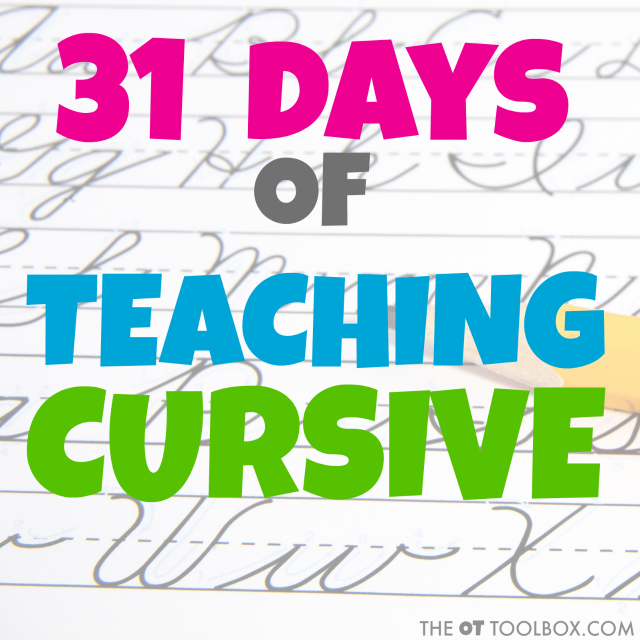
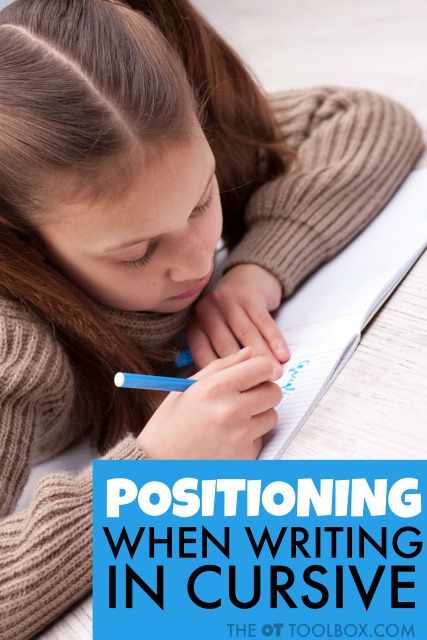
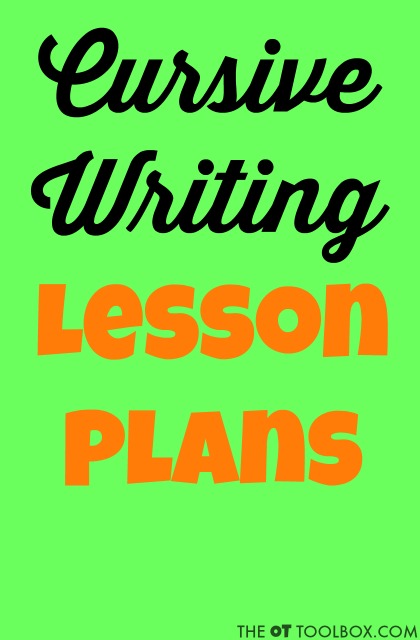
Looking for more information on how to teach cursive writing? You'll love our 31 day series on How to Teach Cursive Writing.
The Handwriting Book breaks down the functional skill of handwriting into developmental areas. These include developmental progression of pre-writing strokes, fine motor skills, gross motor development, sensory considerations, and visual perceptual skills. Each section includes strategies and tips to improve these underlying areas.
- Strategies to address letter and number formation and reversals
- Ideas for combining handwriting and play
- Activities to practice handwriting skills at home
- Tips and strategies for the reluctant writer
- Tips to improve pencil grip
- Tips for sizing, spacing, and alignment with overall improved legibility

Colleen Beck, OTR/L is an occupational therapist with 20+ years experience, graduating from the University of Pittsburgh in 2000. Colleen created The OT Toolbox to inspire therapists, teachers, and parents with easy and fun tools to help children thrive. As the creator, author, and owner of the website and its social media channels, Colleen strives to empower those serving kids of all levels and needs. Want to collaborate? Send an email to contact@theottoolbox.com.
parkerthentolfthat.blogspot.com
Source: https://www.theottoolbox.com/cursive-writing-alphabet-and-easy-order/
0 Response to "Continuous Cursive Letter Continuous Cursive Letter Paragraph"
Post a Comment